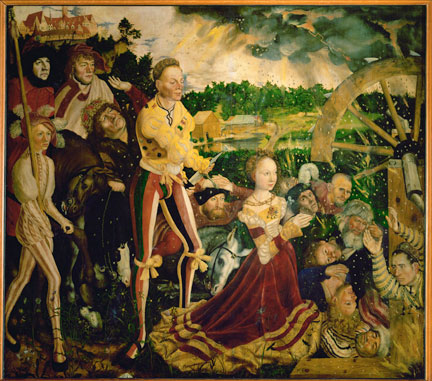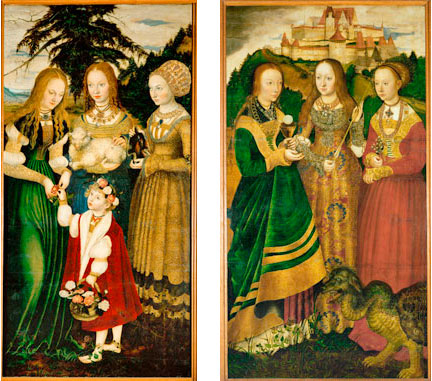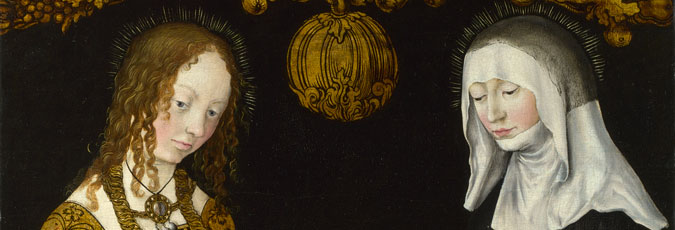Subjects
NG6511.1 depicts Saint Genevieve and Saint Apollonia. Saint Genevieve (422–512) was the patron saint of Paris and protector of the Parisians during the invasions of the Huns and Franks. She holds the candle that miraculously relit after being extinguished by the devil, when she was praying alone in church at night. Her pendant may be intended to represent the Greek letters for alpha and omega, the beginning and end of the Greek alphabet, symbolising God or Christ. Her skirt is a rich green, with bands of gold damask, and is worn over a purple underskirt. Her gold bodice bears the letters GSE and is worn over a white shirt with red lacing on the sleeves and a red frontlet with black lacing; her lower left-hand sleeve is of gold damask while her lower right-hand sleeve is a grey textile striped with red. She wears a gold chain around her shoulders and a narrower gold chain with a pendant looped once around her neck. Her brown hair is bound in plaits, one of which can be seen curling around the back of her right arm, and she wears a narrow black headband. Saint Apollonia of Alexandria (died 249) holds a pair of pincers (also represented on the pendant of her necklace); her teeth were extracted during her martyrdom. She wears a bright red dress with a semi-transparent black chequered shawl around her shoulders. Her fair hair falls in curls over her shoulders.
NG6511.2 depicts Saint Christina and Saint Ottilia. Saint Christina of Bolsena (third century AD) stands on the millstone to which she was tied when thrown into the Lake of Bolsena; she miraculously floated. Her shoulder-length curling hair is brown and she wears a dress of gold damask patterned with red and black, with a black diaper-patterned bodice. Around her neck is a heavy gold chain and a gold pendant from which hangs pearls. Saint Ottilia (died c.720) holds a book on which rest a pair of eyeballs, a reference to the blindness miraculously cured at her baptism. She wears the black habit of a Benedictine Abbess (she was the abbess of the convent of Hohenburg and patron saint of Alsace).
The original ensemble: 'The St Catherine Altarpiece'
The two National Gallery panels once formed the outer faces of the shutters of Cranach’s 'The St Catherine Altarpiece', signed and dated 1506. The central panel showing the martyrdom of the saint and the inner faces of the shutters (figs 9a–c) are in the Gemäldegalerie, Dresden. Two copies of the altarpiece were made in 1586 and 1596 by Daniel Fritsch of Torgau (see Copies).12 The altarpiece was evidently brought to Dresden from Torgau in 1736, but by 1786 the fronts and reverses of the shutters had been separated (see Provenance). The inner shutters depict Saints Dorothy, Agnes and Cunigunde, and Saints Barbara, Ursula and Margaret; there has been some debate concerning which shutter was originally fixed to the left of the centre panel and which to the right (see below).


'The St Catherine Altarpiece' was one of Cranach’s first and most important commissions after becoming court painter in 1505 to the Electors of Saxony, Frederick the Wise and Johann the Steadfast (see NG6538). It depicts the high drama of the events preceding the martyrdom of Saint Catherine of Alexandria (c.287–c.305). According to legend, she defeated 50 philosophers in theological argument, prompting them to convert to Christianity and consequently to be condemned to death. Refusing to marry the Roman emperor, she was herself tortured and condemned to be killed by being attached to a spiked wheel. Through divine intervention the wheel broke apart, its splinters killing some of the spectators. On witnessing this miracle 200 soldiers converted to Christianity and were instantly beheaded, before Catherine herself was herself executed by beheading with a sword.
The two spectators on the left of the scene depicted in the central panel of the altarpiece have been identified as portraits of the elector Frederick the Wise (on the left) and, less certainly, Johann the Steadfast (see NG6538); an alternative identification proposed for the second figure is Duke Joachim I of Brandenburg.13 It is notable that the underdrawing of the heads of the central panel that may represent the electors shows very little change, whereas that for the other heads has undergone many alterations, suggesting that they did not need to follow the specific patterns which portraying the rulers would have necessitated.14 The small boy with Saint Dorothy on the shutter is possibly intended to be a portrait of Johann Friedrich, the son of Johann the Steadfast and nephew of Frederick the Wise (see NG6539).15 Other portraits have also been proposed, for which the evidence is more tenuous; the vividness of the representation of the heads of the figures in the altarpiece may be the result of Cranach’s use of lifelike models rather than reflecting an intention to include a range of portraits.16 Cranach may have drawn inspiration from Dürer for facial as well as figural and compositional models.17 Dürer’s woodcut of the same subject of around 1497/8 has generally been identified as his compositional starting point.18
Two castles feature in the background, one in the centre panel and one in the shutter with Saint Barbara. It has been argued that they are Coburg and Torgau, or two views of Coburg, which the buildings seem most closely to resemble. Coburg stands on a hill, unlike Torgau, which is situated on a plain next to a river. While it seems certain that the castle in the shutter is Coburg, that in the centre panel might represent another of the castles or hunting lodges owned by the electors of Saxony, such as their favoured hunting lodge of Lochau. However, no certain representation survives for comparison, although it might possibly be shown in the background of Cranach’s woodcut of 1506 representing a deerhunt.19
Of the saints grouped on the inner shutters, Saint Dorothy (died c.311) is represented with a small boy carrying a basket of flowers. According to her legend, she sent such a child to the unbelieving lawyer Theophilus as a sign of her heavenly destination after he challenged her faith on the way to her martyrdom, asking her to send him flowers and fruit from the garden of heaven. Next to her is Saint Agnes, with her attribute of a lamb, and Saint Cunigunde (died 1033), wife of the Emperor Henry II. When the latter was accused of infidelity, she walked on red-hot ploughshares or coals, which she is shown holding. In the other group of saints is Saint Barbara, represented as the patron saint of the dying and holding a chalice with the sacrament which would be conferred as one of the last rites; Saint Ursula, who was martyred with arrows at Cologne; and Saint Margaret, who escaped alive from being swallowed by Satan in the form of a dragon.
The original location of the altarpiece
'The St Catherine Altarpiece' was almost certainly made for the chapel of the electors of Saxony at Wittenberg Castle, which was dedicated to All Saints. The rebuilding of the chapel began in the 1490s and was completed in 1511.20 Following near destruction it was rebuilt in 1760–70 and restored in the nineteenth century.21 The chapel contained thirteen altars: the dedications included those to Sigismund, Wenzel and Elogius, which date from the fourteenth century; and those to All Saints (the high altar, dedicated in 1506), Maria, the Holy Cross and Anne.22 Catherine was the patron saint of the philosophical faculty of the University of Wittenberg, founded by the electors of Saxony in 1502. Since the castle chapel also served as the university chapel from 1507, it is reasonable to suppose that Cranach’s altarpiece depicting the saint’s martyrdom was made for this location.23 As well as being rich in altarpieces and church vessels, the chapel also housed the numerous relics collected by the electors. The female saints represented on the inner faces of the altarpiece all reflect reliquaries of the saints owned by the electors;24 these were represented by Cranach in woodcut illustrations to the catalogue of the relics published in 1509, the Wittenberger Heiligthumsbuch. Of the saints shown on the outer faces, the electors owned a reliquary of Saint Ottilia (fig. 10), a relic of ‘ein partickel’ of Saint Christina, seven pieces of the leg of Saint Apollonia and some of her teeth, but nothing, it appears, of Saint Genevieve.25
The fact that the altarpiece is likely to have been at Torgau when it was copied in 1586 and 1596 by Daniel Fritsch (see Copies), and that it is first certainly recorded at Torgau in 1610 and is probably to be identified there in 1601 (see Provenance), has led to the alternative suggestion that it was originally made for the chapel of the elector’s castle of Schloss Hartenfels at Torgau; some have suggested that this is represented in the background of the altarpiece.26 This seems less probable, not only because Torgau is unlikely to be represented (see above). The small chapel at Torgau was dedicated to Saint Martin and had no evident connection to Saint Catherine. 'The St Catherine Altarpiece', if created for Wittenberg, might have been removed to Torgau at any point from 1525 onward when, with the advent of the Reformation, some of the contents of the Wittenberg chapel were removed and taken to the castle itself. Later, between 1547 and 1552, when the Elector Johann Friedrich was the prisoner of the Emperor Charles V (see NG 6538), Cranach himself removed works including precious metal objects from the castle, some of which were melted down, others later sold off by the heirs of Lucas Cranach the Younger (1515–1586).27 The first copy of the altarpiece by Daniel Fritsch of Torgau was made during the year of the death of the Elector Augustus in 1586 and the accession of his son Christian I, who ruled until 1591, and its original location is unknown.28 The second copy was made in 1596 during the rule of Christian II, elector until 1611, evidently commissioned by Katharina von Brandenburg (1549–1602), wife of Johann Friedrich, Elector of Brandenberg, for the church in Alt-Tempelhof, Berlin, where it remains today.
Reconstruction: The arrangement of the shutters
The joins of the National Gallery panels and those of the Dresden panels match exactly. The National Gallery panel depicting saints Genevieve and Apollonia matches the Dresden panel with saints Dorothy, Agnes and Cunigunde; and the National Gallery panel with saints Christina and Ottilia matches that with saints Barbara, Ursula and Margaret.29 While the correspondence of the joins makes it clear which inner face belonged to which outer face, this does not elucidate the problem of which shutter was on the left and which on the right. The arrangement which prevailed in the Dresden Gallery in the nineteenth century and earlier in the last century placed the shutter with saints Barbara, Ursula and Margaret on the left. (The other shutter, representing saints Dorothy, Agnes and Cunigunde, had been sold (see Provenance) and was acquired by the Gemäldegalerie, Dresden, in 1996.30) There is no certainty that the original altarpiece was assembled in this way, and the obvious compositional objection is that this arrangement places the two castles adjacent to each other, which seems unlikely to have been Cranach’s original intention. Against this, however, it might be argued that the position of the boy giving the basket of roses to Saint Dorothy is more logically placed turning inwards towards the centre panel (when placed on the right) rather than outwards (when on the left). The altarpiece is currently assembled to avoid the conjunction of castles, with Saint Dorothy and her companions on the left-hand shutter, leaving the other saints with the castle in the background to form the right wing. This arrangement is reflected in the copy by Daniel Fritsch of 1596 at Berlin, but again there can be no certainty that the triptych was always assembled in this way (the Wörlitz copy is dismembered and the backs and fronts of the shutters split). In this arrangement the closed shutters would show saints Genevieve and Apollonia on the left, and saints Christina and Ottilia on the right. No evidence remains concerning the original frame of the altarpiece, which may have included a predella, as well as a carved upper portion including figures.31
Further sections
13. Koepplin and Falk 1974–6, [vol. II], p. 268; Marx 2005, pp. 103–5.
14. I am grateful to Christoph Schölzel of the Gemäldegalerie, Dresden, for showing me the infrared reflectograms of the altarpiece and discussing them with me.
15. Marx and Mössinger 2005, p. 110, notes that the underdrawing of the boy shows a face in profile and links this to a drawing of an angel by Schongauer known in two versions, one formerly in the Koenigs collection and one today in the Kupferstichkabinett, Berlin.
16. See ibid., pp. 98–105 and Heydenreich 2007, pp. 303–11. Posse 1936 proposed that other male heads were portraits.
17. See Marx 1996, pp. 34–8 and Marx and Mössinger 2005, pp. 98–105.
18. Marx 1996, pp. 34–8.
19. Kolb 2005, pp. 382–3.
20. Bellmann 1979, pp. 91–2.
21. Ibid., pp. 90–3.
22. Ibid., p. 246.
23. Marx 1996, p. 38.
24. Bellmann 1979, pp. 245–53, p. 257ff. The chapel probably housed Dürer’s Adoration of the Magi.
25. Marx and Mössinger 2005, pp. 38–9; see nos vii, xii and xiii in the Wittenberger Heiligthumsbuch.
26. Friedländer and Rosenberg 1978, no. 15; Marx 1996, p. 38.
27. Bellman 1979, p. 242.
28. It is suggested that this copy was originally made for a church in Anhalt which was reformed in 1596: see Melzer 2005.
29. Giebe and Schölzl in Marx 1996, pp. 63–88, esp. p. 63.
30. It was loaned to Dresden from 1931; see Kolb 2005, pp. 381–2.
31. Ibid., p. 382.

